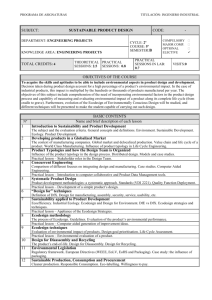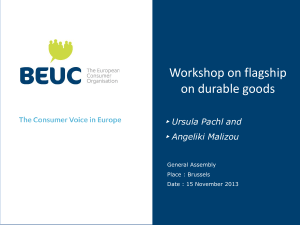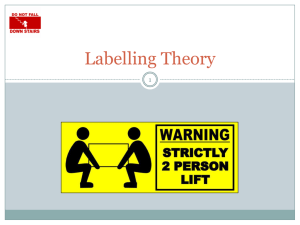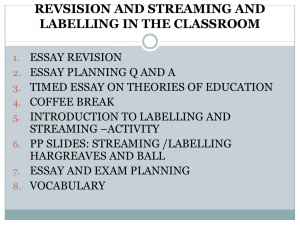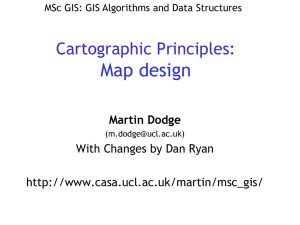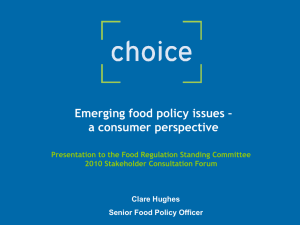label
advertisement
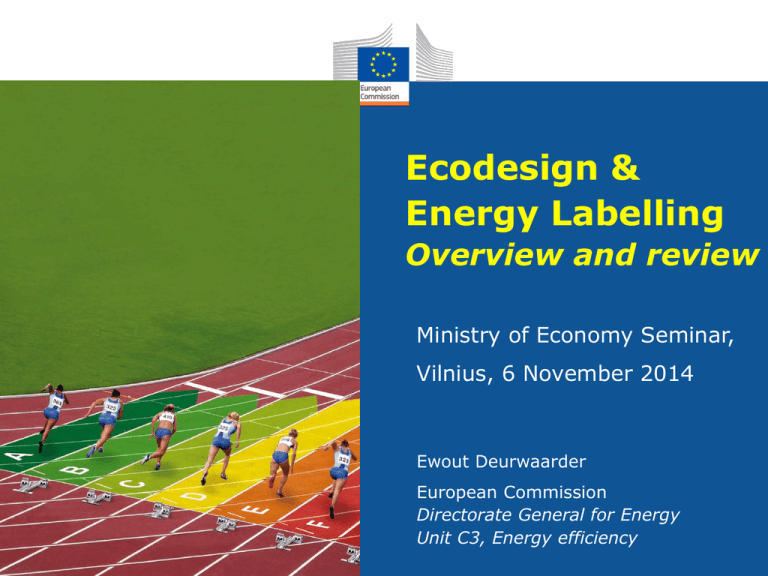
Ecodesign & Energy Labelling Overview and review Ministry of Economy Seminar, Vilnius, 6 November 2014 Ewout Deurwaarder European Commission Directorate General for Energy Unit C3, Energy efficiency Unit C3, Energy efficiency 1. State of Play 2. Review of the Directives + future work plan 3. Information on specific products How do we achieve energy efficiency in product design? Combined effect ensures a dynamic improvement of the market: Supply side Ecodesign Directive 2009/125/EC Efficient products Demand side Energy Labelling Directive 2010/30/EU + Labelling of Tyres (Regulation 1222/2009) + Energy Star (Regulation 106/2008) Both Directives are «frameworks» defining the «rules» for setting product-specific requirements through Regulations. Ecodesign Directive (2009/125/EC) • Allows to set requirements for environmental performance of energy-related products • Main focus has been on energy in the use-phase • Can address other environmental parameters and life-cycle phases • Requirements have to be met in order to place a product on the market • Requirements are harmonised across the EU Energy Labelling Directive (2010/30/EU) Allows to specify an energy label for energy-related products The label shows energy efficiency in the use phase Use of other essential resources/ information during use also shown Manufacturers have to supply the label; dealers have to show it Product-specific measures 24 ecodesign regulations (+4 amendments) 11 energy labelling Regulations (+1 amendment) 1275/2008 Electric power consumption standby and off mode 107/2009 Simple set-top boxes 1059/2010 Household dishwashers 244+859/2009 Non-directional household lamps 1060/2010 Household refrigerating appliances 245/2009 1061/2010 Household washing machines 1062/2010 Televisions 626/2011 Air conditioners 392/2012 Household tumble driers 874/2012 Electrical lamps and luminaires 665/2013 Vacuum cleaners Fluorescent lamps for high intensity discharge lamps +347/2010 278/2009 External power supplies 640/2009 + 4/2014 Electric motors 641/2009 + 622/2012 Circulators 642/2009 Televisions 643/2009 Household refrigerating appliances 1015/2010 Household washing machines 811/2013 Space heaters 1016/2010 Household dishwashers 812/2013 Water heaters & storage tanks 327/2011 Industrial fans 65/2014 Domestic ovens, hobs and range hoods 206/2012 Airco and comfort fans 547/2012 Water pumps 514/2014 Amending all cocerning label on the internet 932/2012 Household tumble driers 1194/2012 Directional lamps 1222/2009 Fuel efficiency and other essential parameters 617/2013 Computers and servers 228/2011 Wet grip testing method for C1 tyres 666/2013 Vacuum cleaners 801/2013 Networked standby 813/2013 Space heaters 814/2013 Water heaters & storage tanks 66/2014 Domestic ovens, hobs and range hoods 548/2014 Power transformers ../.. Ventilation products Tyre labelling + 2 implementing regulations 1235/2011 Wet grip grading of C2, C3 tyres, measurement of tyres rolling resistance and verification procedure 2 voluntary agreements COM (2012) 684 Complex set top boxes COM (2013) 23 Imaging equipment On-going work Regulations under review Regulations under development Ventilation products (labelling) Professional refrigeration Local space heaters Household dishwashers Household refrigerating appliances Household washing machines Household tumble driers Pumps Solid fuel boilers Set-top Boxes Air heating products Electrical lamps and luminaires (stage 6) Electronic displays Commercial refrigeration Other motors External power supplies Lighting (non-directional and tertiary, and special purpose) Products under study (work plan 2012-14) Window products Compressors Water related products Professional wet appliances Lighting controls Smart appliances/meters Voluntary agreements under development Game consoles Machine tools Power cables Enterprise servers Steam boilers Fractional horse power motors < 200W Process for developing product-specific regulations Step 1-7 Step 8-10 Entry into force and application Regulations enter into force 20 days after publication in the Official Journal of EU, but .. .. requirements only become applicable from the date(s) specified in the regulation Either 'Common commencement dates' (1 January or 1 July) or exactly X years after entry into force First requirements usually (about) 1 or 2 years after publication Implementation of Regulations Commission provides: • References to transitional or final measurement standards (published in the Official Journal of the EU) • Guidelines (for selected products) • Energy label templates • Energy label generator (new) • Consumer's guides (new) http://ec.europa.eu/energy/efficiency/labelling/household_en.htm Enforcement Market surveillance is the role of national authorities, it includes: Inspecting technical documentation Product testing Inspection of labels in shops and on the internet Random and/or risk based sampling Cooperation with other market surveillance authorities Market surveillance regulation 765/2008 Applies to all Union harmonisation legislation on products Applies also to Ecodesign, Energy Labelling and Tyre Labelling New proposal under negotiation in European Parliament and Council Member States' cooperation on enforcement Administrative Cooperation (ADCO): • Discuss common challenges • Agree on interpretation questions relevant to surveillance EU-funded projects: • Joint actions (e.g. testing) • Common procedures, exchange best practices Voluntary agreements Ecodesign Directive provides for self-regulation as alternative, under certain conditions Two agreements have been endorsed by the Commission (imaging equipment; complex set-top boxes) Thus, no ecodesign regulations However, regulation on stand-by & off-mode still applies Provisions for voluntary agreements • Ecodesign Directive, ANNEX VIII • Self-regulation • (referred to in Article 17) Requirements: self-regulatory initiatives must comply with all provisions of the Treaty (in particular internal market and competition rules), international engagements of the Community and the following non-exhaustive list of indicative criteria: • 1. Openness of participation • 2. Added value • 3. Representativeness • 4. Quantified and staged objectives • 5. Involvement of civil society • 6. Monitoring and reporting • 7. Cost-effectiveness of administering a self-regulatory initiative • 8. Sustainability • 9. Incentive compatibility (Policy consistency ) Guidelines for voluntary agreements General criteria ensuring coherence Under preparation, draft presented to the Ecodesign Consultation Forum June 2014. Would address: • Process transparency and information to the public • Level of ambition; market share covered • Compliance checks, auditing 1. State of Play 2. Review of the Directives + future work plan 3. Information on specific products Timeline Review Energy Labelling & Ecodesign •May 2013- June 2014 •Sept – Nov 2013 •Sept 2013 – Oct 2014 evaluation study public consultation consumer labelling study •19 Feb 2014 •20-21 Feb 2014 •11 June 2014 label layout meeting international conference Consultation Forum • •1st quarter 2015 …….. Commission report + any proposal Review: Results Achieved 38 measures 763 TWh 162 Mtoe Expected yearly savings by 2020 Major challenges Scope • • • • Environmental aspects Products versus systems Internet of Things Smart appliances Process • Data & Resources Energy label • Rescaling Communication Compliance/Market surveillance 22 Scope • Beyond energy-related products? • Further environmental aspects? 23 Scope • Products versus systems Package label for heating systems 24 Scope • Internet of Things • Stand-by power Source: Alan Meier 25 Scope • Smart appliances/demand response 26 Highlights of the evaluation study Substantial, cost-effective energy savings, but not capturing full potential • Revise energy label • Address market surveillance • Increase support for rule-making process Mandatory product registration would help market surveillance and the rule-making process Highlights of the consumer study • Online testing of label framing elements Highlights of the consumer study •Green to red label scales are understood Highlights of the consumer study •Potential new elements are not well-understood 100% 90% 80% 70% 60% 50% 40% 30% 20% 10% 0% 39% 32% 43% 68% 61% 57% 68% 32% Info No info Grey arrows (indicating open scale) Correct Info No info Benchmark marker (indicating best available technology) Incorrect Highlights of the consumer study Share of respondents •Purchasing behaviour best for alphabetic scale Price premium for the more energy efficient product 2nd phase consumer study Testing in brick-and-mortar shops Communication 33 Ecodesign/Labelling work plan 2015-2017 Study on-going assessing potential energy and other environmental impact savings: http://www.ecodesign-wp3.eu/ 108 products studied; in-depth assessment of 16 products Study final in January 2015 Commission to decide on work plan. Key question how much effort into revisions vs. new products 1. State of Play 2. Review of the Directives + future work plan 3. Information on specific products New regulations (selected highlights) Published Computers and servers – ecodesign – applies July 2014 Vacuum cleaners – ecodesign & label – Sept 2014 Label on the internet – Jan 2015 Coffee machines – ecodesign standby – Jan 2015 Cooking appliances – ecodesign & label – Jan/Feb 2015 Power transformers – ecodesign – July 2015 Space and water heaters - ecodesign & label – Sept 2015 New regulations (selected highlights) •Decided - not yet published •Ventilation (ecodesign & label) •Professional refrigeration (ecodesign) •Gas, liquid and electric local space heaters (ecodesign) •Solid fuel local space heaters (ecodesign) •Solid fuel boilers (ecodesign) New regulations (selected highlights) •On-going - not yet decided •Professional refrigeration (label) •Local space heaters (label) •Solid fuel boilers (label) •Commercial refrigeration (ecodesign & label) •Air heating products (ecodesign) Vacuum cleaners Label and ecodesign apply since Sept 2014 (Regulations 665 & 666/2013) Ecodesign Sept 2014 Ecodesign Sept 2017 Labelling Sept 2014 Labelling Sept 2017 < 62 kWh/y < 43 kWh/y A-G +kWh/annum A+++ to D +kWh/annum Rated input power < 1600 W < 900 W - - Dust pick-up carpet ≥ 0.70 ≥ 0.75 small A-G small A-G Dust pick-up hard floor ≥ 0.95 ≥ 0.98 small A-G small A-G Dust reemission - ≤ 1% small A-G small A-G Sound - ≤ 80 dB(A) number number Durability - motor and hose - - Parameter Energy efficiency Vacuum cleaners Energy efficiency takes into account both the power input and the performance in picking up dust Commission published in August/September: • References to standards in the Official Journal EU • Guidelines Commission will review the durability requirements before they start to apply Information requirements for the specific type of fans used in vacuum cleaners have been removed from the fans regulation (industrial) Fans Regulation 327/2011 (electric power 125 W-500 kW) Requirements for Jan 2013 and Jan 2015 Review by April 2015 • feasibility of reducing the number of defined fan types • reduce number of exemptions, including allowances for dual use fans Study on-going; 1st stakeholder meeting Oct 2014 Ventilation Ecodesign & labelling adopted July 2014 Labelling still under scrutiny by Parliament and Council Labelling only for residential ventilation (max. flow rate 250 m³/h; or 1000 m³/h and declared as exclusively residential) Ecodesign requirements different for residential and non-residential Apply from Jan 2016 Professional refrigeration Storage cabinets, blast cabinets, process chillers & condensing units Ecodesign voted; applies July 2016 For blast cabinets only indicative product information Walk-in cold rooms not regulated; for review in 5 years Label for only for storage cabinets; not yet adopted Commercial Refrigeration Display cabinets, potentially including: segment cabinets beverage coolers small ice cream freezers vending machines soft-scoop ice cream cabinets Ecodesign & Energy Labelling Consultation Forum meeting July 2014 Adoption envisaged late 2015 Air heating products, cooling products and high-temperature chillers Potentially including: air heating products ≤ 1 MW cooling products ≤ 2 MW fan coil units (information requirements only) high temperature process chillers Ecodesign only Consultation Forum meeting Sept 2013 Adoption envisaged mid-2015 Solid fuel boilers ecodesign Ecodesign Regulatory Committee voted on 13 October 2014 Requirements for 2020: • • • • • 77% (based on GCV), 75% for boilers ≤20 kW PM 40 mg/m3 at 10% O2, 60 for manual boilers OGC 20 mg/m3 at 10% O2, 30 for manual boilers CO 500 mg/m3 at 10% O2, 700 for manual boilers NOx 200 mg/m3 at 10% O2, 350 for fossil fuel boilers Solid fuel boilers - label Not yet adopted by the Commission Intention: same label as for other space heaters (Regulation 811/2013) • A++ to G label from ? • A+++ to D label from 25 Sept 2019 • Package label Member State experts supported an approach in which biomass condensing boilers reach class A++ Gas/liquid/electric local space heaters Ecodesign voted; applies Jan 2018 Energy efficiency requirements, + NOx for gas & liquid Indication for electric: "only suitable for well insulated spaces or occasional use" Labelling only for gas and liquid; combined label with solid fuels; not yet adopted Solid fuel local space heaters Ecodesign Regulatory Committee voted on 14 October 2014 on requirements for 2022: Product Energy efficiency Open fronted 30% Closed fronted 65% Closed fronted pellets 79% Cookers 65% PM mg/m3 * OGC mg/m3 CO mg/m3 NOx mg/m3 Open fronted 50 100 2000 200 Closed fronted 40 100 1500 200 (300 fossil fuel) Closed fronted pellets 20 40 300 200 Cookers 40 100 1500 200 (300 fossil fuel) Product * also Norwegian and British test methods allowed with separate limit values Local space heaters - label Not yet adopted by the Commission Intention: one label for gas, liquid and solid fuel local space heaters • A++ to G label • Best biomass appliances can reach A++ • Best fossil fuel appliances can reach A Thank you for your attention!
